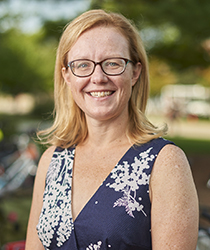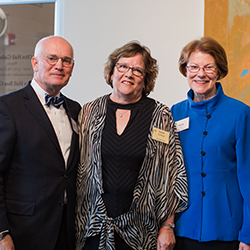Alumnae Profiles: Winter 2020
Keeping kids connected to their tribe
Kathryn Henningfeld Fort ’99
 The Washington Post recently described Kathryn Fort as one of the country’s foremost experts on the Indian Child Welfare Act (ICWA). “So that was pretty cool,” she says with trademark deadpan.
The Washington Post recently described Kathryn Fort as one of the country’s foremost experts on the Indian Child Welfare Act (ICWA). “So that was pretty cool,” she says with trademark deadpan.
For nearly 15 years, Fort has worked to safeguard the 1978 federal law that prioritizes placing American Indian and Alaska Native children in foster and adoptive homes of family members, members of their tribe, or with other American Indian or Alaska Native families. Before Congress passed the law, the National Indian Child Welfare Association reports, 25 to 35 percent of all native children were being removed and of those 85 percent were placed in homes outside their tribes, even when willing relatives were available. The United States has a dark history of ripping native children from their communities earlier than that. In the late 19th and early 20th century, the federal government removed American Indian children from their families en masse and shipped them to boarding schools, where many were abused or killed. “Even today, Native children are four times more likely than white children to be placed in foster care in the first hearing before a judge,” Fort says. “Ensuring their families receive all of the services possible and keeping those children connected to their tribe is the purpose of ICWA. I have been lucky enough to see what it means when a child gets to grow up in her tribe, and ICWA can make sure that happens.”
The U.S. Court of Appeals for the 5th Circuit agreed in November to rehear the lawsuit Brackeen v. Bernhardt. The plaintiffs, who include non-Indian adoptive parents of Native children and the states of Texas, Indiana, and Louisiana, argue ICWA is race based and violates the Equal Protection Clause of the U.S. Constitution. Defendants in the case include the federal government, federal agencies, and several tribes. Fort serves as one of the lawyers representing the tribes. Speaking about the appeal, Fort told The Washington Post she wished Texas had put the resources used for this case toward improving the lives of foster children in the state.
“Given that a federal judge this week [Nov. 5] fined Texas $50,000 a day until they fix their broken child welfare system,” Fort says, “it seems beyond the pale for them to try to continue to strike down a law that is designed to help children and families in that very system heal and reunify.”
The case is almost certain to end up at the highest court in the land. “I don’t want to go to the Supreme Court,” says Fort, who majored in history at Hollins. “Very little good comes out of the Supreme Court these days.”
When she’s not writing legal briefs, Fort can often be found at her main gig: directing the Indian Law Clinic at Michigan State University College of Law. There, she guides students as they draft appellate briefs or policy papers for American Indian tribes.
Fort’s American Indian Children and the Law, the first casebook ever published on American Indian child welfare, came out this year. She spent 10 years writing the book, the result of years of discussions with Native lawyers and families, tribal leaders, and professors.
In addition to her duties at Michigan State, Fort works as a consultant, writing needs assessments of tribal courts in Alaska, which are used to secure federal funding from the Bureau of Indian Affairs. That means she’s forever flying into remote villages on teeny airplanes in the worst possible weather.
“They don’t really want you coming in the summer,” Fort explains. “The summer is when they’re doing all the hunting and fishing for the winter, so we go a lot in the winter and it can get dicey quick trying to get out to the villages. I hate the little planes so much. I love meeting everyone and doing the work, but man, I hate the process of getting there.”
Helping tribal courts to increase their funding is positive work, Fort believes, but she calls it “incremental.” She points to how many of the native communities have no law enforcement presence to protect them. “What we do is very small compared to what needs to be done.”
—Beth JoJack ’98
![]()
A tangible legacy
Susan Woods Jennings ’73

Last September, Jennings won the 2019 Perry F. Kendig Award, jointly sponsored by Roanoke College and Hollins. She is flanked by Roanoke College President Michael Maxey and Interim President Nancy Oliver Gray. Photo by Carissa Szuch Divan
Few leaders have left as visible of a mark on the Star City as Susan Jennings.
She’s the reason children delight over the Trojan Dog, a 10-foot-tall fiberglass doggie created by Roanoke artist Ann Glover that sits beside the Raleigh Court Library. She’s why drivers on Interstate 581 strain their necks to get a glimpse of Global Harmony, a light-up sculpture of a giant bronze hand holding a silver globe by Arizona artist Stephen Fairfield, as they pass over the corner of Wells Avenue and Williamson Road
This summer Jennings retired from her post as Roanoke’s first-ever arts and culture coordinator. By her last day on the job, the city’s collection had grown to 160 pieces of public art; 71 of those pieces were acquired after Jennings took the job.
Back in 2002, Roanoke launched a Percent for Art program, where city leaders put aside one percent of Roanoke’s capital budget toward buying public art. The city hired Jennings in 2006 and she began working with members of the Roanoke Arts Commission to draft comprehensive guidelines for how to select and install the pieces. Over the years, Jennings’ job description evolved to include everything from cataloguing the city’s art pieces to organizing concerts in parks to figuring out whether In a Tangle, a sculpture of a comb that did double duty as a bike rack, could be restored after a piece fell off (it couldn’t).
Of the many public art projects Jennings has coordinated over the years, her favorite piece is Reading Garden by Colorado’s Madeline Wiener. The installation sits next to the Gainsboro Library. Members of that community worked with the artist to name the books carved out of limestone and provide images that were sandblasted onto their surfaces. The citizen collaboration continued on the day of installation, when workers began at 7 in the morning and were still at it by 7 that night due to problems that ranged from a crane getting stuck in the mud to a fire alarm erroneously going off. When it got dark, a community leader quickly arranged for someone to bring down a spotlight. “The neighbors just pitched in so beautifully,” Jennings recalls.
Before going to work for the city of Roanoke, Jennings spent 14 years leading the Arts Council of the Blue Ridge, the now-defunct nonprofit organization that advocated for the arts, staged exhibits, and led workshops for students, artists, and cultural organizations. Earlier in her career, Jennings came up with the idea for ArtVenture, which began in 1993 as a hands-on art center aimed at fourth and fifth graders at what was then called the Art Museum of Western Virginia in Roanoke. That project evolved into what is now an exploratory gallery at the Taubman Museum of Art, where children can do things like play dress-up on a real stage or paint or learn about 3D printing.
Jennings, who majored in art history, believes her work creating a robust arts and culture scene in Roanoke has given a boost to the city’s economic well-being. Sculptures, ballet performances, and concerts in the park elevate the quality of life in the city, which helps to entice professionals and businesses. “It’s just another arrow in the quiver that gets people to locate here,” she says. Jennings points to a recent study conducted by Washington D.C.’s Americans for the Arts that found that arts and culture generates $64 million annually for Roanoke’s economy.
“You always want to leave a job on a high note,” Jennings says of her decision to retire this year. “I felt like we had laid a really good base and it’s time for somebody else to come in with some new innovative ideas.” That somebody turned out to be Doug Jackson M.F.A. ’06, a longtime member of the Roanoke Arts Commission and an evangelist for building creative communities. “He’s going to be excellent,” Jennings raves.
While Jennings is excited to have more time to spend with her husband and grandchildren, she hasn’t hung up her hat entirely. She serves on the boards of the Carilion Clinic’s Dr. Robert L.A. Keeley Healing Arts Program, the Changing the Narrative project, which strives to promote racial healing, and the President’s Advisory Board at Hollins.
On September 24, Jennings was honored with a 2019 Perry F. Kendig Award at a ceremony at Roanoke College. The award, cosponsored by Roanoke College and Hollins, was established in 1985 to recognize excellence in arts and culture in Roanoke and is cosponsored by the two institutions. “It was a wonderful way to retire,” Jennings says of the recognition.
—Beth JoJack ’98
